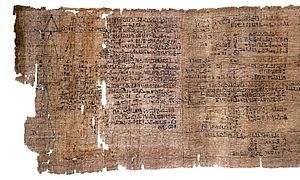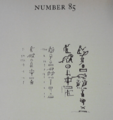Rhind Mathematical Papyrus facts for kids
The Rhind Papyrus is a very old Egyptian scroll that shows us how people in Ancient Egypt used to do math! It's kept safe in the British Museum today.
This amazing papyrus is named after Alexander Henry Rhind, a man from Scotland who was interested in old things. He bought it in 1858 in a city called Luxor in Egypt. It was found when people were digging near a place called the Ramesseum.
The Rhind Papyrus was written around 1650 BC, which is a very long time ago! It's one of the best examples we have of Egyptian math.
Contents
What Math Did Ancient Egyptians Do?
The Rhind Papyrus is full of different kinds of math problems. It covers:
- Arithmetic: This is basic math like adding, subtracting, multiplying, and dividing.
- Algebra: This is where you use letters or symbols to stand for numbers in equations.
- Geometry: This is the study of shapes, sizes, positions, and properties of space.
- Trigonometry: This is a type of math that deals with triangles and angles.
- Fractions: These are parts of a whole number.
Along with another scroll called the Moscow Mathematical Papyrus, the Rhind Papyrus helps us understand how good ancient Egyptians were at math. The Rhind Papyrus is bigger than the Moscow Papyrus, but the Moscow Papyrus is actually older.
Who Wrote the Rhind Papyrus?
The Rhind Papyrus was copied by a scribe named Ahmose. A scribe was someone whose job was to write and copy documents. Ahmose copied it from an even older text that is now lost. He finished copying it around 1550 BC, during a time in Egyptian history called the Second Intermediate Period.
The papyrus is about 33 centimeters (about 13 inches) tall. When all its pieces are put together, it's more than 5 meters (about 16 feet) long! It's written in a special Egyptian writing style called hieratic script.
What Does the Papyrus Say?
At the very beginning of the papyrus, Ahmose says that his book will give "Accurate reckoning for inquiring into things, and the knowledge of all things, mysteries...all secrets." This means he thought his math book was super important and would help people understand many things!
He also wrote:
This book was copied in regnal year 33, month 4 of Akhet, under the majesty of the King of Upper and Lower Egypt, Awserre, given life, from an ancient copy made in the time of the King of Upper and Lower Egypt Nimaatre (?). The scribe Ahmose writes this copy.
This tells us exactly when and by whom the papyrus was copied. It was during the rule of a king named Apophis, who was a Hyksos king. There's also a note about a later year 11, likely from the next king, Khamudi.
Studying the Rhind Papyrus Today
People started to understand and translate the math in the Rhind Papyrus in the late 1800s. It's been studied a lot, and many books and articles have been written about it. Even today, experts are still learning new things from this amazing ancient document!
Images for kids
See also
 In Spanish: Papiro de Ahmes para niños
In Spanish: Papiro de Ahmes para niños






